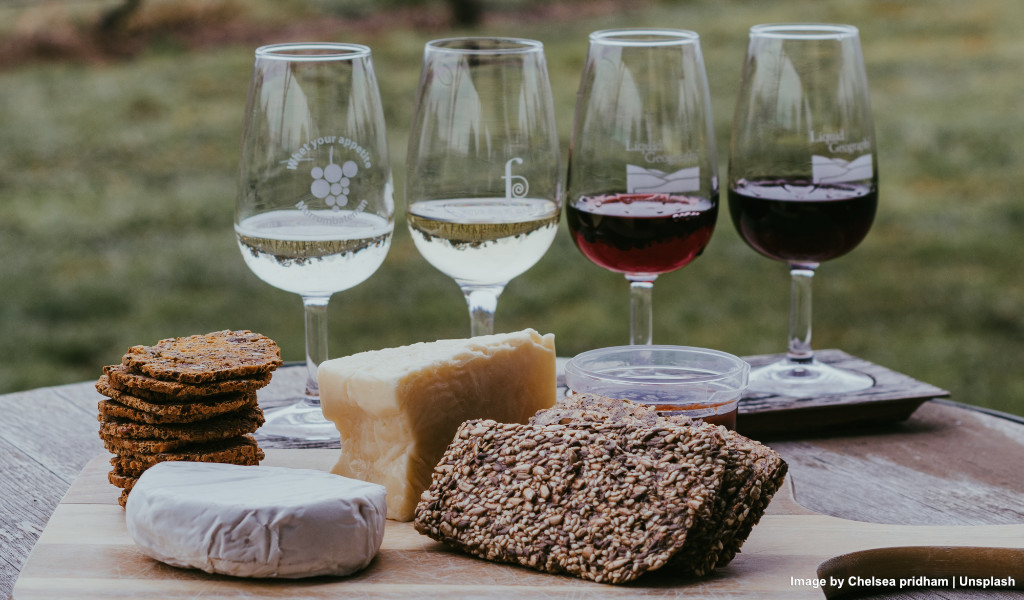
Navigating the countless grape varieties and food options to find that perfect wine pairing can seem daunting. However, while helpful pairing principles exist, finding your ideal match also requires embracing your personal palate.
The joy lies in the journey – popping different corks, swirling, sipping, and learning how flavors intermingle. It’s about balancing intensities, contrasting textures, complementing tastes, and playing with aromas.
With some fundamental know-how and an adventurous spirit, you’ll be hosting dinners that impress guests with your sublime wine and food pairings. So embrace your inner sommelier, have fun with flavor, and create mouthwatering combinations that you can proudly say, “I paired this!”
The Origins of Wine Pairing
The modern art of food and wine pairing really began to take shape in the 17th century. As wine became more readily available in Europe, cooks realized that certain wines complemented particular foods. For example, they noticed the acidity of lighter wines brightened richer dishes, while hearty reds paired well with meat.
French cuisine pioneered many structured pairing guidelines. In the 18th century, Georges Auguste Escoffier created the first a la carte restaurant menus designed specifically for food and wine pairings. Bordeaux wines were prescribed for meat dishes, while fish and seafood were paired with whites from the Loire Valley.
This influenced Britain to adopt more formal dining rules, including the ritual of serving sherries and ports with certain courses.
In America, Thomas Jefferson was one early proponent of wine culture. After visiting vineyards in France, he brought Old World wine knowledge back to the New World. By the mid-20th century, Julia Child and other TV chefs further expanded America’s pairing horizons. Her show highlighted nuanced wine choices beyond just red or white.
From California wine country to the blogosphere, food and wine pairing has now gained mass appeal across the globe. There are even certified sommeliers specially trained in pairing principles. While traditions continue to guide, modern tastemakers keep reinventing the rules – proving that in wine pairing, the only limit is one’s sense of adventure.
The Art of Wine Pairing: Enhancing Your Meal with the Perfect Wine
Selecting the right wine to accompany a meal can elevate the dining experience to new heights. However, with the wide range of wine varieties and food options, pairing wine and food can seem like an intimidating endeavor for many. In this article, we’ll explore the fundamentals of pairing wine with food and provide tips for choosing the perfect bottle for your meal.
Wine Pairing: The Basic Principles
While there are no hard and fast rules for wine pairing, there are a few basic guidelines to keep in mind:
- Complement, don’t overpower – You want the wine to accentuate the flavors in the food, not cover them up. Bold, highly tannic reds can overpower delicate fish dishes, for example.
- Consider weight – Light, crisp whites pair better with light meats like chicken and fish, while hearty reds go better with steak and other heavy meats.
- Match intensity of flavors – A rich, buttery Chardonnay can stand up to the bold flavors in a creamy pasta dish better than a light Pinot Grigio.
- Opposites attract – Sometimes contrasting the food and wine actually brings out the best in both. The acidity in a bright white balance salty foods like cheese.
- Play with textures – Creamy and crispy textures in food call for wines with a silky or acidic feel. Crunchy, fried foods demand a higher acid wine to cut through the fat.
- Don’t forget ethnic cuisine – Spanish Rioja, for example, can complement the flavors of Mexican food beautifully.
Expert Tips for Wine Pairing
Here are some expert tips for choosing the perfect wine for different foods:
- Beef – Cabernet Sauvignon, Malbec, Shiraz
- Fish – Pinot Noir, Chardonnay, Sauvignon Blanc
- Chicken – Chardonnay, Rosé, Pinot Grigio
- Pork – Pinot Noir, Rioja, Chianti
- Pasta – Chianti, Merlot, Zinfandel
- Salad – Sauvignon Blanc, Rosé, Champagne
- Pizza – Sangiovese, Montepulciano, Chianti
- Cheese – Port, Pinot Noir, Cabernet Sauvignon
- Chocolate – Port, Muscat, Lambrusco
Final Thoughts
Don’t be afraid to experiment with different wines, vintages, and regions until you find that sublime pairing. Part of the fun is in the exploration! Pay attention to the aromas, flavors, textures, and “finish” of both the wine and food, and determine what elements complement each other. With a little practice, you’ll be hosting food and wine parties worthy of 5-star restaurants!


